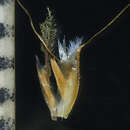Global Distribution
provided by Bibliotheca Alexandrina LifeDesk
Native to Afghanistan and Pakistan, eastwards to China, Sri Lanka, tropical southeast Asia and Australia.
- author
- BA Cultnat
- provider
- Bibliotheca Alexandrina
Habitat
provided by Bibliotheca Alexandrina LifeDesk
Cultivated as an ornamental (Dwarf Bamboo).
- author
- BA Cultnat
- provider
- Bibliotheca Alexandrina
Life Expectancy
provided by Bibliotheca Alexandrina LifeDesk
- author
- BA Cultnat
- provider
- Bibliotheca Alexandrina
Comments
provided by eFloras
This species is much rarer in Taiwan. Often it is found in tufts on rocky banks.
- license
- cc-by-nc-sa-3.0
- copyright
- Missouri Botanical Garden, 4344 Shaw Boulevard, St. Louis, MO, 63110 USA
Comments
provided by eFloras
Dwarf Bamboo is commonly cultivated as an ornamental grass. It is often found in tufts in rocky banks. It grows in hotter situations than Pogonatherum crinitum and at lower altitudes.
- license
- cc-by-nc-sa-3.0
- copyright
- Missouri Botanical Garden, 4344 Shaw Boulevard, St. Louis, MO, 63110 USA
Description
provided by eFloras
Saccharum paniceum Lam., Encycl. 1: 595. pl. 40. f. 1. 1783.
Pogonatherum saccharoideum Beauv., Ess. Agrost. 176. p1. 11. f. 7. 1812.
Culm stout, tufted, 3-8-noded, nodes bearded. Ligule about 0.4 mm long, ciliate. Inflorescence a single raceme, about 2.5 cm long; rachis-joint ciliate, about 1/2 as long as the spikelet. Spikelets paired, dimorphic, pedicellate spikelet 1/2 the length of the sessile one, both with 2 long awns; sessile spikelet oblong, about 2.5-3 mm long. Glumes papery, the lower truncate, fimbriate, about 2.5 mm long, 5-nerved, awnless, the upper with a long awn, deltoid-lanceolate, upper margins fimbriate; lower lemma membranous, oblong, minutely 2-toothed, nerveless; upper lemma membranous, 2-cleft, with a long awn arising from the sinus; upper palea membranous, margins folded, truncate and fimbriate, as long as the lemma or slightly longer.
- license
- cc-by-nc-sa-3.0
- copyright
- Missouri Botanical Garden, 4344 Shaw Boulevard, St. Louis, MO, 63110 USA
Description
provided by eFloras
Culms stiffly erect at base, 30–60 cm tall, 1–2 mm in diam., hard and unbranched in lower part, repeatedly branched forming dense fascicles of very slender branchlets in upper part. Leaf sheaths glabrous or puberulous, mouth long ciliate; leaf blades stiff, 1.5–5.5 × 0.15–0.4 cm, scabrid, apex acuminate. Raceme 1.3–3 cm (excluding awns), yellowish; rachis internodes and pedicels ca. 1/2 spikelet length, hairs silky white. Sessile spikelet 2.3–3 mm, thinly cartilaginous; callus hairs shorter than spikelet; lower glume scabrid or puberulous on back, apex ciliate with 0.5–1 mm hairs; upper glume awn 1.3–2 cm; lower floret staminate, lemma slightly shorter than lower glume, palea subequaling lemma; awn of upper lemma 1.5–1.8 cm, weakly geniculate near base, column not strongly demarcated, limb very fine. Stamens 2, anthers ca. 1.8 mm. Pedicelled spikelet similar to sessile but smaller; lower glume awnless. Fl. and fr. Mar–Oct.
- license
- cc-by-nc-sa-3.0
- copyright
- Missouri Botanical Garden, 4344 Shaw Boulevard, St. Louis, MO, 63110 USA
Description
provided by eFloras
Tufted perennial; culms wiry, stiff, usually erect, up to 60 cm high. Leaf-blades 1-5 cm long, 1-3 mm wide. Racemes 1.5-3 cm long, dense, borne upon a flexuous peduncle, bearing numerous long delicate yellowish-brown awns. Spikelets elliptic-oblong, 2.5-3 mm long, the callus bearded with white hairs up to 1.5 mm long; lower glume a little shorter than the spikelet; lower floret male with 2 stamens, very rarely bisexual, lemma hyaline; upper glume and upper lemma bearing slender flexuous awns 10-15 mm long, floret with 2 stamens.
- license
- cc-by-nc-sa-3.0
- copyright
- Missouri Botanical Garden, 4344 Shaw Boulevard, St. Louis, MO, 63110 USA
Distribution
provided by eFloras
Himalaya (Nepal, Sikkim), India, Ceylon, Burma, Thailand, Indo-China, China, Taiwan, Malaysia.
- license
- cc-by-nc-sa-3.0
- copyright
- Missouri Botanical Garden, 4344 Shaw Boulevard, St. Louis, MO, 63110 USA
Distribution
provided by eFloras
Distributed in India, Burma and Ceylon and grows in rather hotter and lower situations than Pogonatherum crinitum. Also found in Vietnam, Malaysia an extending to Australia.
- license
- cc-by-nc-sa-3.0
- copyright
- Missouri Botanical Garden, 4344 Shaw Boulevard, St. Louis, MO, 63110 USA
Distribution
provided by eFloras
Guangdong, Guangxi, Guizhou, Hubei, Hunan, Sichuan, Taiwan, Yunnan [Afghanistan, Bhutan, India, Indonesia, Laos, Malaysia, Myanmar, Nepal, Pakistan, Thailand, Vietnam; SW Asia (Arabia), Australia (Queensland)].
- license
- cc-by-nc-sa-3.0
- copyright
- Missouri Botanical Garden, 4344 Shaw Boulevard, St. Louis, MO, 63110 USA
Distribution
provided by eFloras
Distribution: Pakistan (Punjab, N.W.F.P. & Kashmir); Afghanistan, India, Burma and Sri Lanka; China; Australia; cultivated throughout its range and in East and South Africa.
- license
- cc-by-nc-sa-3.0
- copyright
- Missouri Botanical Garden, 4344 Shaw Boulevard, St. Louis, MO, 63110 USA
Elevation Range
provided by eFloras
900-3200 m
- license
- cc-by-nc-sa-3.0
- copyright
- Missouri Botanical Garden, 4344 Shaw Boulevard, St. Louis, MO, 63110 USA
Flower/Fruit
provided by eFloras
Fl. & Fr. Per.: March-July, sometimes still fruiting in September, especially in Kashmir.
- license
- cc-by-nc-sa-3.0
- copyright
- Missouri Botanical Garden, 4344 Shaw Boulevard, St. Louis, MO, 63110 USA
Habitat
provided by eFloras
Mountain slopes, roadsides, streams; 100–2300 m.
- license
- cc-by-nc-sa-3.0
- copyright
- Missouri Botanical Garden, 4344 Shaw Boulevard, St. Louis, MO, 63110 USA
Synonym
provided by eFloras
Saccharum paniceum Lamarck, Encycl. 1: 595. 1785; Per-otis polystachya Willdenow; Pogonatherum saccharoideum P. Beauvois, nom. illeg. superfl.
- license
- cc-by-nc-sa-3.0
- copyright
- Missouri Botanical Garden, 4344 Shaw Boulevard, St. Louis, MO, 63110 USA

